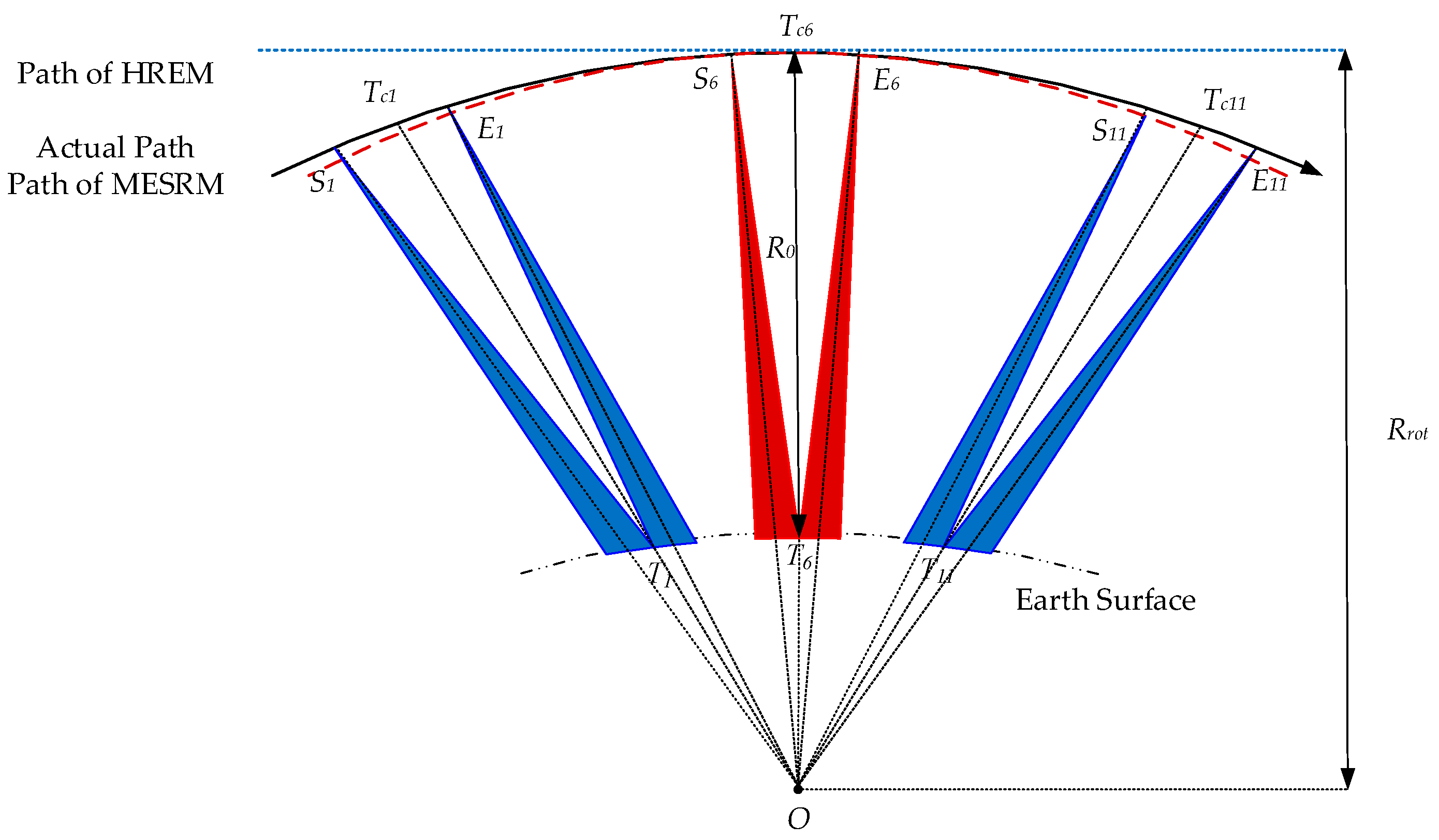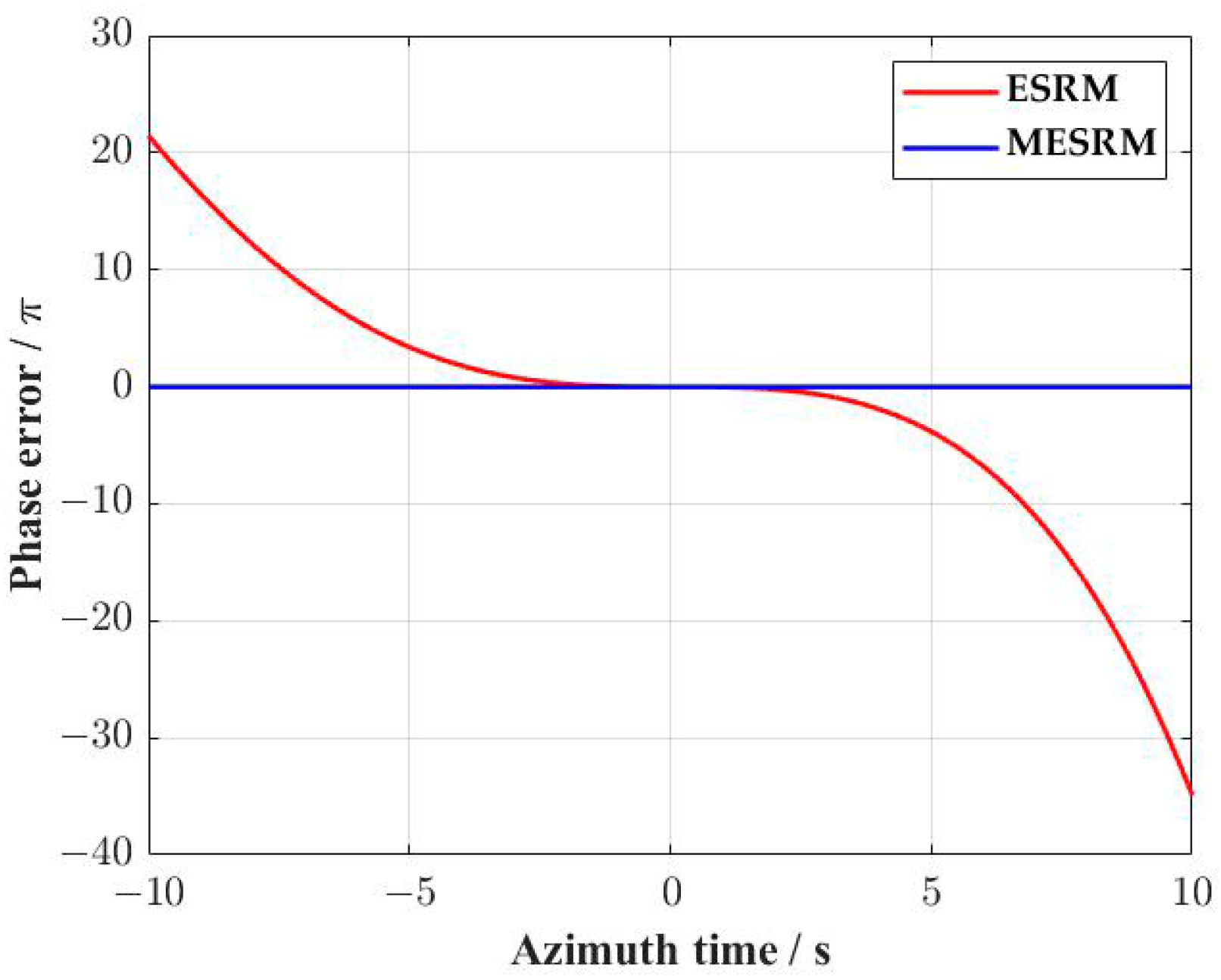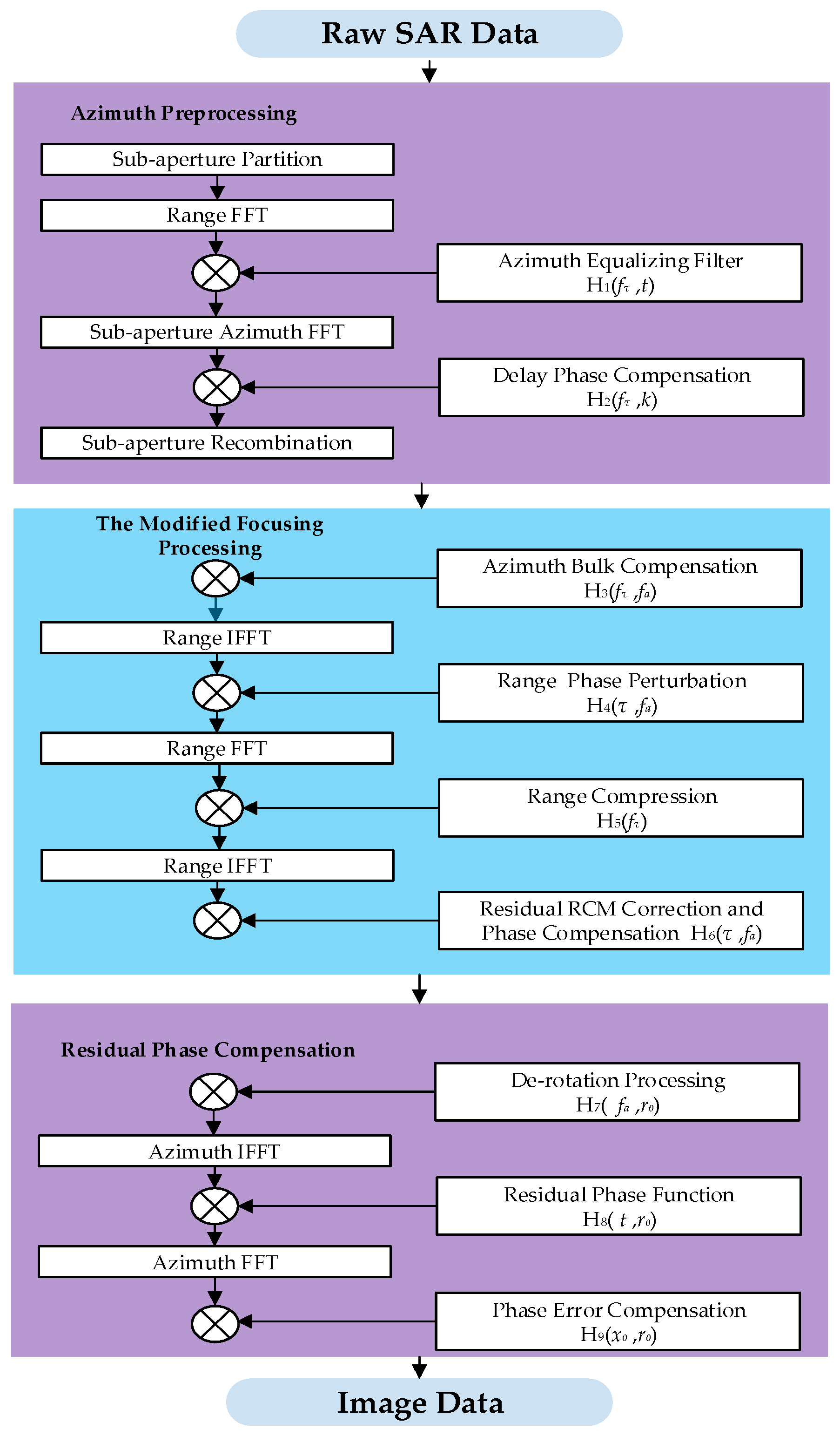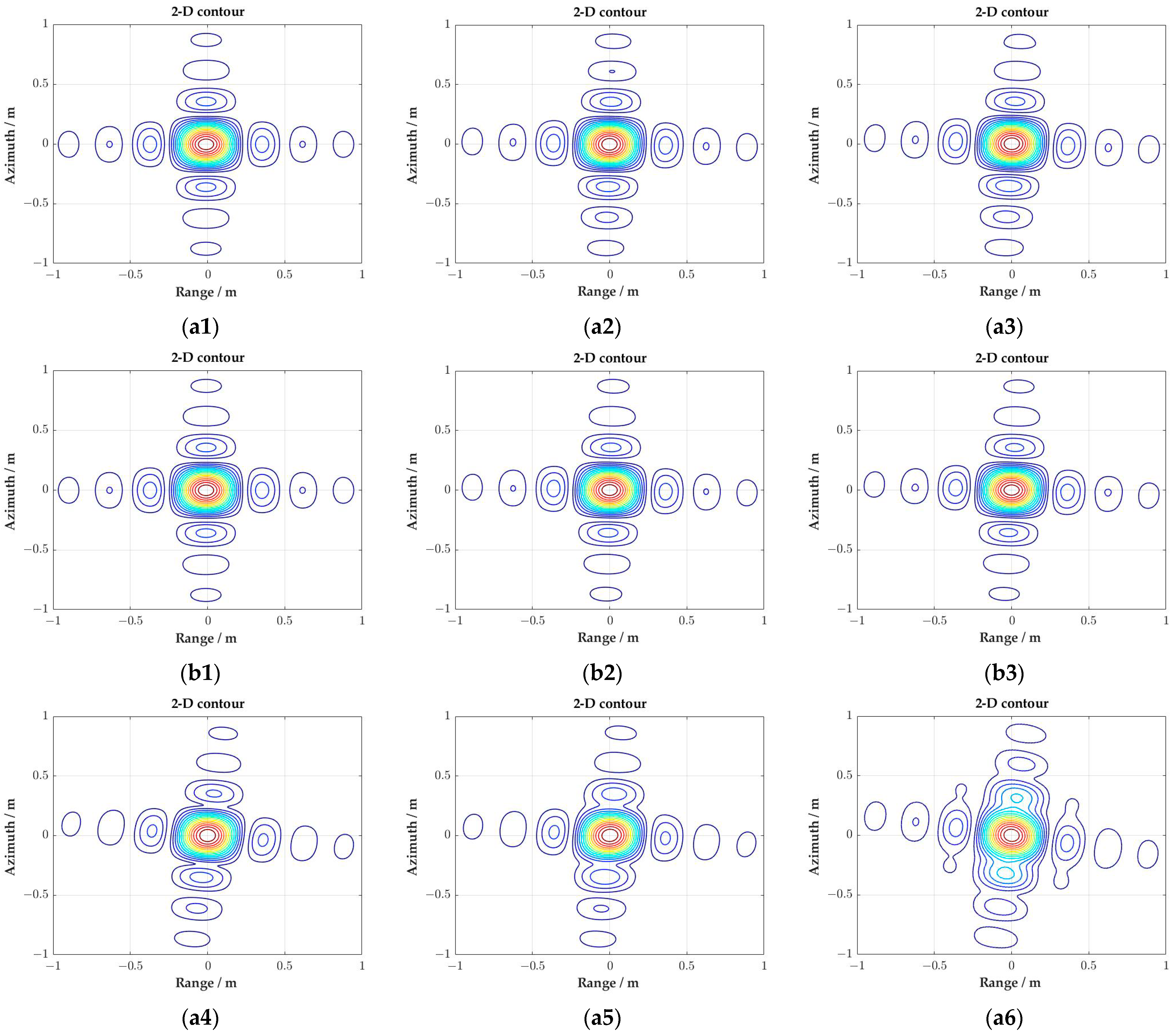A Novel Imaging Algorithm for High-Resolution Wide-Swath Space-Borne SAR Based on a Spatial-Variant Equivalent Squint Range Model
Abstract
:1. Introduction
2. The Spatial-Variant System and Signal Model
2.1. The Analysis of Spatial-Variant System
2.2. The Estabishment of Spatial-Variant Signal Model
3. Imaging Algorithm
3.1. Azimuth Preprocessing
3.2. The Modified Focusing Processing
3.2.1. Azimuth Bulk Compensation
3.2.2. Range Phase Perturbation
- The first term : this is a constant component, which varies according to the range position deviation of targets and is negligible when only the amplitude of the image is considered.
- The second term : this is a linear component, which causes a range position shift to the targets. The shift is a quadratic term of time deviation in the range direction and is expressed as
- The third term : the quadratic component equalizes the range frequency modulation rate of different range cells. The range frequency modulation rate is replaced by
- The fourth term : the cubic component is same for all targets, which leads to slightly asymmetric side lobes.
3.2.3. Range Compression
3.2.4. Differential RCM Correction and Doppler Phase Compensation
3.3. Residual Phase Compensation
4. Simulations and Results
4.1. Validation of the Range Phase Perturbation
4.2. Validation of the Doppler Phase Perturbation
4.3. Computational Complexity Analysis
5. Discussion
- The constant component : this term brings a range position shift and causes a phase error , which can be ignored when only the amplitude of the imaging result is considered. Their expressions are given by (45) and (46)
- The linear component : it leads to a small spatially varying Doppler centroid shift to the echo signal , which is a quadratic term as a function of the azimuth time. The linear component will cause a range shift and an azimuth shift to the target position. Moreover, these position shifts should be considered in the geometric calibration
- The quadratic component : this item is the desired component, which removes the deviation of the DFMR within the same range cell.
- The cubic component : it is a cubic Doppler phase modulation, which is azimuth-invariant and can be identically compensated for all targets, otherwise slight asymmetry of the side lobes will arise for the imaging results. This small phase modulation could be negligible in the derivation of the stationary phase point.
6. Conclusions
Author Contributions
Funding
Institutional Review Board Statement
Informed Consent Statement
Data Availability Statement
Conflicts of Interest
Abbreviations
| SAR | Synthetic Aperture Radar |
| HRWS | High-Resolution Wide-Swath |
| ESRM | Equivalent Squint Range Model |
| HREM | Hyperbolic Range Equation Model |
| DRM4 | the fourth-order Doppler Range Model |
| MESRM | Modified Equivalent Squint Range Model |
| SV-ESRM | Spatial-Variant Equivalent Squint Range Model |
| MHCA | Modified Hybrid Correlation Algorithm |
| RCM | Range Cell Migration |
| TSX-NG | TerraSAR-X Next Generation |
| RDA | Range Doppler Algorithm |
| HHCA | High-order Hybrid Correlation Algorithm |
| JTDRA | Joint Time-Doppler Resampling Algorithm |
| FSA | Frequency Scaling Algorithm |
| CSA | Chirp Scaling Algorithm |
| NCS | Nonlinear Chirp Scaling |
| DFMR | Doppler Frequency Modulation Rate |
| POSP | Principle of Stationary Phase |
| PTS | Point Target Spectrum |
| PRF | Pulse Repetition Frequency |
| FFT | Fast Fourier Transform |
| IFFT | Inverse Fast Fourier Transform |
| PSLR | Peak Side-Lobe Ratio |
| ISLR | Integrated Side-Lobe Ratio |
| IRW | Impulse Response Width |
References
- Ciuonzo, D.; Carotenuto, V.; De Maio, A. On Multiple Covariance Equality Testing with Application to SAR Change Detection. IEEE Trans. Signal Process. 2017, 65, 5078–5091. [Google Scholar] [CrossRef]
- Liu, G.; Li, L.; Jiao, L.; Dong, Y.; Li, X. Stacked Fisher autoencoder for SAR change detection. Pattern Recognit. 2019, 96, 106971. [Google Scholar] [CrossRef]
- Yang, W.; Chen, J.; Liu, W.; Wang, P. Moving Target Azimuth Velocity Estimation for the MASA Mode Based on Sequential SAR Images. IEEE J. Sel. Top. Appl. Earth Observ. Remote Sens. 2017, 10, 2780–2790. [Google Scholar] [CrossRef] [Green Version]
- Jung, H.; Lu, Z.; Shepherd, A.; Wright, T. Simulation of the SuperSAR Multi-Azimuth Synthetic Aperture Radar Imaging System for Precise Measurement of Three-Dimensional Earth Surface Displacement. IEEE Trans. Geosci. Remote Sens. 2015, 53, 6196–6206. [Google Scholar] [CrossRef]
- Townsend, W. An initial assessment of the performance achieved by the Seasat-1 radar altimeter. IEEE J. Ocean. Eng. 1980, 5, 80–92. [Google Scholar] [CrossRef] [Green Version]
- Moreira, A.; Prats-Iraola, P.; Younis, M.; Krieger, G.; Hajnsek, I.; Papathanassiou, K.P. A tutorial on synthetic aperture radar. IEEE Geosci. Remote Sens. Mag. 2013, 1, 6–43. [Google Scholar] [CrossRef] [Green Version]
- Villano, M.; Krieger, G.; Moreira, A. Staggered SAR: High-Resolution Wide-Swath Imaging by Continuous PRI Variation. IEEE Trans. Geosci. Remote Sens. 2014, 52, 4462–4479. [Google Scholar] [CrossRef]
- Cerutti-Maori, D.; Sikaneta, I.; Klare, J.; Gierull, C.H. MIMO SAR Processing for Multichannel High-Resolution Wide-Swath Radars. IEEE Trans. Geosci. Remote Sens. 2014, 52, 5034–5055. [Google Scholar] [CrossRef]
- De Almeida, F.Q.; Younis, M.; Krieger, G.; Moreira, A. A New Slow PRI Variation Scheme for Multichannel SAR High-Resolution Wide-Swath Imaging. In Proceedings of the 2018 IEEE International Geoscience and Remote Sensing Symposium, Valencia, Spain, 22–27 July 2018; pp. 3655–3658. [Google Scholar]
- De Almeida, F.Q.; Younis, M.; Prats-Iraola, P.; Rodriguez-Cassola, M.; Krieger, G.; Moreira, A. Slow Pulse Repetition Interval Variation for High-Resolution Wide-Swath SAR Imaging. IEEE Trans. Geosci. Remote Sens. 2021, 59, 5665–5686. [Google Scholar] [CrossRef]
- Janoth, J.; Gantert, S.; Koppe, W.; Kaptein, A.; Fischer, C. TerraSAR-X2—Mission overview. In Proceedings of the 2012 IEEE International Geoscience and Remote Sensing Symposium, Munich, Germany, 22–27 July 2012; pp. 217–220. [Google Scholar]
- Janoth, J.; Gantert, S.; Schrage, T.; Kaptein, A. Terrasar next generation—Mission capabilities. In Proceedings of the 2013 IEEE International Geoscience and Remote Sensing Symposium-IGARSS, Melbourne, VIC, Australia, 21–26 July 2013; pp. 2297–2300. [Google Scholar]
- Janoth, J.; Jochum, M.; Petrat, L.; Knigge, T. High Resolution wide Swath—The Next Generation X-Band Mission. In Proceedings of the IGARSS 2019—2019 IEEE International Geoscience and Remote Sensing Symposium, Yokohama, Japan, 28 July–2 August 2019; pp. 3535–3537. [Google Scholar]
- Mittermayer, J.; Moreira, A.; Loffeld, O. Spotlight SAR data processing using the frequency scaling algorithm. IEEE Trans. Geosci. Remote Sens. 1999, 37, 2198–2214. [Google Scholar] [CrossRef]
- Sun, X.; Yeo, T.S.; Zhang, C.; Lu, Y.; Kooi, P.S. Time-varying step-transform algorithm for high squint SAR imaging. IEEE Trans. Geosci. Remote Sens. 1999, 37, 2668–2677. [Google Scholar]
- Eldhuset, K. A new fourth-order processing algorithm for spaceborne SAR. IEEE Trans. Aerosp. Electron. Syst. 1998, 34, 824–835. [Google Scholar] [CrossRef] [Green Version]
- Eldhuset, K. Ultra high resolution spaceborne SAR processing. IEEE Trans. Aerosp. Electron. Syst. 2004, 40, 370–378. [Google Scholar] [CrossRef]
- Eldhuset, K. Spaceborne Bistatic SAR Processing Using the EETF4 Algorithm. IEEE Geosci. Remote Sens. Lett. 2009, 6, 194–198. [Google Scholar] [CrossRef]
- Wang, P.; Liu, W.; Chen, J.; Niu, M.; Yang, W. A High-Order Imaging Algorithm for High-Resolution Spaceborne SAR Based on a Modified Equivalent Squint Range Model. IEEE Trans. Geosci. Remote Sens. 2015, 53, 1225–1235. [Google Scholar] [CrossRef] [Green Version]
- Wu, C.; Liu, K.Y.; Jin, M. Modeling and a Correlation Algorithm for Spaceborne SAR Signals. IEEE Trans. Aerosp. Electron. Syst. 1982, 18, 563–575. [Google Scholar] [CrossRef]
- Bamler, R. A comparison of range-Doppler and wavenumber domain SAR focusing algorithms. IEEE Trans. Geosci. Remote Sens. 1992, 30, 706–713. [Google Scholar] [CrossRef]
- Li, Y.; Zhang, Z.; Xing, M.; Bao, Z. Bistatic Spotlight SAR Processing Using the Frequency-Scaling Algorithm. IEEE Geosci. Remote Sens. Lett. 2008, 5, 48–52. [Google Scholar] [CrossRef]
- Raney, R.K.; Runge, H.; Bamler, R.; Cumming, I.G.; Wong, F.H. Precision SAR processing using chirp scaling. IEEE Trans. Geosci. Remote Sens. 1994, 32, 786–799. [Google Scholar] [CrossRef]
- Moreira, A.; Huang, Y. Airborne SAR processing of highly squinted data using a chirp scaling approach with integrated motion compensation. IEEE Trans. Geosci. Remote Sens. 1994, 32, 1029–1040. [Google Scholar] [CrossRef]
- Moreira, A.; Mittermayer, J.; Scheiber, R. Extended chirp scaling algorithm for air- and spaceborne SAR data processing in stripmap and ScanSAR imaging modes. IEEE Trans. Geosci. Remote Sens. 1996, 34, 1123–1136. [Google Scholar] [CrossRef]
- Liu, W.; Sun, G.; Xia, X.; Chen, J.; Guo, L.; Xing, M. A Modified CSA Based on Joint Time-Doppler Resampling for MEO SAR Stripmap Mode. IEEE Trans. Geosci. Remote Sens. 2018, 56, 3573–3586. [Google Scholar] [CrossRef]
- Wong, F.H.; Cumming, I.G.; Neo, Y.L. Focusing Bistatic SAR Data Using the Nonlinear Chirp Scaling Algorithm. IEEE Trans. Geosci. Remote Sens. 2008, 46, 2493–2505. [Google Scholar] [CrossRef] [Green Version]
- Sun, G.; Xing, M.; Wang, Y.; Yang, J.; Bao, Z. A 2-D Space-Variant Chirp Scaling Algorithm Based on the RCM Equalization and Subband Synthesis to Process Geosynchronous SAR Data. IEEE Trans. Geosci. Remote Sens. 2014, 52, 4868–4880. [Google Scholar]
- Huang, L.; Qiu, X.; Hu, D.; Han, B.; Ding, C. Medium-Earth-Orbit SAR Focusing Using Range Doppler Algorithm with Integrated Two-Step Azimuth Perturbation IEEE Geosci. Remote Sens. Lett. 2015, 12, 626–630. [Google Scholar] [CrossRef]
- Davidson, G.W.; Cumming, I.G.; Ito, M.R. A chirp scaling approach for processing squint mode SAR data. IEEE Trans. Aerosp. Electron. Syst. 1996, 32, 121–133. [Google Scholar] [CrossRef]
- Huang, L.; Qiu, X.; Hu, D.; Ding, C. Focusing of Medium-Earth-Orbit SAR with Advanced Nonlinear Chirp Scaling Algorithm. IEEE Trans. Geosci. Remote Sens. 2011, 49, 500–508. [Google Scholar] [CrossRef]
- Wang, P.B.; Liu, W.; Chen, J.; Yang, W.; Han, Y. Higher order nonlinear chirp scaling algorithm for medium Earth orbit synthetic aperture radar. J. Appl. Remote Sens. 2015, 9, 096084. [Google Scholar] [CrossRef] [Green Version]
- Prats, P.; Scheiber, R.; Mittermayer, J.; Meta, A.; Moreira, A. Processing of Sliding Spotlight and TOPS SAR Data Using Baseband Azimuth Scaling. IEEE Trans. Geosci. Remote Sens. 2010, 48, 770–780. [Google Scholar] [CrossRef] [Green Version]
- Prats, P.; Scheiber, R.; Mittermayer, J.; Meta, A.; Moreira, A.; Sanz-Marcos, J. A SAR processing algorithm for TOPS imaging mode based on extended chirp scaling. IEEE Int. Geosci. Remote Sens. Symp. 2007, 148–151. [Google Scholar]
- An, D.; Huang, X.; Jin, T.; Zhou, Z. Extended Two-Step Focusing Approach for Squinted Spotlight SAR Imaging IEEE Trans. Geosci. Remote Sens. 2012, 50, 2889–2900. [Google Scholar] [CrossRef]
- Luo, Y.; Zhao, B.; Han, X.; Wang, R.; Song, H.; Deng, Y. A Novel High-Order Range Model and Imaging Approach for High-Resolution LEO SAR. IEEE Trans. Geosci. Remote Sens. 2014, 52, 3473–3485. [Google Scholar] [CrossRef]















| HHCA | MHCA | JTDRA | |
|---|---|---|---|
| Capable of handling spatial variation | No | Yes | Yes |
| Processing efficiency | High | High | Relatively low |
| Notation | Interpretation | Notation | Interpretation |
|---|---|---|---|
| Slant range at the Doppler center time | Wavelength of the carrier. | ||
| Equivalent radar velocity | Equivalent squint angle | ||
| Fast time | Slow time. | ||
| Doppler centroid frequency | Doppler frequency modulation rate | ||
| Cubic coefficient in MESRM | Quartic coefficient in MESRM | ||
| The first-order deviation of the DFMR | The second-order deviation of the DFMR | ||
| Beam-center-time of the target | Azimuth position of the target | ||
| Speed of light | Range phase modulation rate |
| Description | Value | Units |
|---|---|---|
| Height | 514 | km |
| Eccentricity | 0.0011 | - |
| Inclination | 98 | deg |
| Longitude of ascending node | 0 | deg |
| Argument of perigee | 90 | deg |
| Wavelength | 0.03 | m |
| Bandwidth | 600 | MHz |
| Sample frequency | 900 | MHz |
| PRF | 4250 | Hz |
| Reference slant range | 593,429.6 | m |
| Look angle | 30 | deg |
| Antenna length | 4.8 | m |
| Azimuth resolution | 0.25 | m |
| Hybrid factor | 0.10417 | - |
| Central latitude | 0 | deg |
| Target | Azimuth | Range | ||||||||
|---|---|---|---|---|---|---|---|---|---|---|
| ρa (m) | ρa,c (m) | IRW | PSLR (dB) | ISLR (dB) | ρr (m) | ρr,c (m) | IRW | PSLR (dB) | ISLR (dB) | |
| 1 | 0.237 | 0.234 | 1.49% | −13.49 | −10.68 | 0.223 | 0.221 | 0.54% | −13.39 | −9.97 |
| 6 | 0.236 | 0.234 | 0.9% | −13.25 | −10.30 | 0.223 | 0.221 | 0.54% | −13.31 | −9.83 |
| 11 | 0.236 | 0.234 | 0.95% | −13.14 | −10.46 | 0.223 | 0.221 | 0.54% | −13.43 | −9.99 |
| 12 | 0.225 | 0.221 | 1.58% | −13.50 | −10.70 | 0.222 | 0.221 | 0.45% | −13.41 | −9.97 |
| 17 | 0.223 | 0.221 | 0.54% | −13.25 | −10.30 | 0.223 | 0.221 | 0.54% | −13.25 | −9.83 |
| 22 | 0.224 | 0.221 | 1.04% | −13.15 | −10.46 | 0.223 | 0.221 | 0.59% | −13.42 | −9.99 |
| 23 | 0.206 | 0.203 | 1.63% | −13.49 | −10.69 | 0.223 | 0.221 | 0.54% | −13.41 | −9.98 |
| 28 | 0.204 | 0.203 | 0.41% | −13.24 | −10.30 | 0.223 | 0.221 | 0.54% | −13.24 | −9.83 |
| 33 | 0.205 | 0.203 | 1.04% | −13.21 | −10.50 | 0.223 | 0.221 | 0.54% | −13.43 | −9.99 |
| MHCA | JTDRA | |
|---|---|---|
| Times of range FT | 4 | 4 |
| Times of azimuth FT | 3 | 3 |
| Times of complex multiplications | 9 | 8 |
| Times of interpolations | 0 | 2 |
Publisher’s Note: MDPI stays neutral with regard to jurisdictional claims in published maps and institutional affiliations. |
© 2022 by the authors. Licensee MDPI, Basel, Switzerland. This article is an open access article distributed under the terms and conditions of the Creative Commons Attribution (CC BY) license (https://creativecommons.org/licenses/by/4.0/).
Share and Cite
Guo, Y.; Wang, P.; Chen, J.; Men, Z.; Cui, L.; Zhuang, L. A Novel Imaging Algorithm for High-Resolution Wide-Swath Space-Borne SAR Based on a Spatial-Variant Equivalent Squint Range Model. Remote Sens. 2022, 14, 368. https://doi.org/10.3390/rs14020368
Guo Y, Wang P, Chen J, Men Z, Cui L, Zhuang L. A Novel Imaging Algorithm for High-Resolution Wide-Swath Space-Borne SAR Based on a Spatial-Variant Equivalent Squint Range Model. Remote Sensing. 2022; 14(2):368. https://doi.org/10.3390/rs14020368
Chicago/Turabian StyleGuo, Yanan, Pengbo Wang, Jie Chen, Zhirong Men, Lei Cui, and Lei Zhuang. 2022. "A Novel Imaging Algorithm for High-Resolution Wide-Swath Space-Borne SAR Based on a Spatial-Variant Equivalent Squint Range Model" Remote Sensing 14, no. 2: 368. https://doi.org/10.3390/rs14020368
APA StyleGuo, Y., Wang, P., Chen, J., Men, Z., Cui, L., & Zhuang, L. (2022). A Novel Imaging Algorithm for High-Resolution Wide-Swath Space-Borne SAR Based on a Spatial-Variant Equivalent Squint Range Model. Remote Sensing, 14(2), 368. https://doi.org/10.3390/rs14020368







